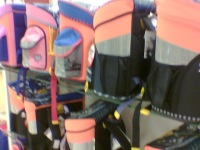
Schultüten
In preparation for our daughter starting school I have had to start looking into another German tradition. Not only does she need her Schulranzen, but she will also expect a Schultüte on her first day.
Actually, I first came across the concept as a student in Germany in 1993 whilst watching a TV show called “Supergrips” (known elsewhere as “Blockbusters”) where the main prize was a Wundertüte – a sort of mystery prize. At the time, I did not realise the significance of this item as part of German school life.
But be it a Schultüte or the infamous Wundertüte, it is the same shape: a large cone.
The Schultüte cone is colourfully decorated – often with the same sort of designs as the Schulranzen, and is purchased empty several weeks before school starts.
Into this cone then go small presents that the child receives on their first day. These may be small books, or stationary, or even sweets. The cones are certainly large enough to fit all three into them!
So given the possible contents, this cone can get quite heavy. Which makes it even more amazing that the children carry it around with them on their first day at school – proud of what they have been given, but not even knowing what is inside. You see, they don’t actually open the cone until they get home!
Our Schultüte is now awaiting its contents. Any suggestions?

 This summer our daughter will be starting
This summer our daughter will be starting 

